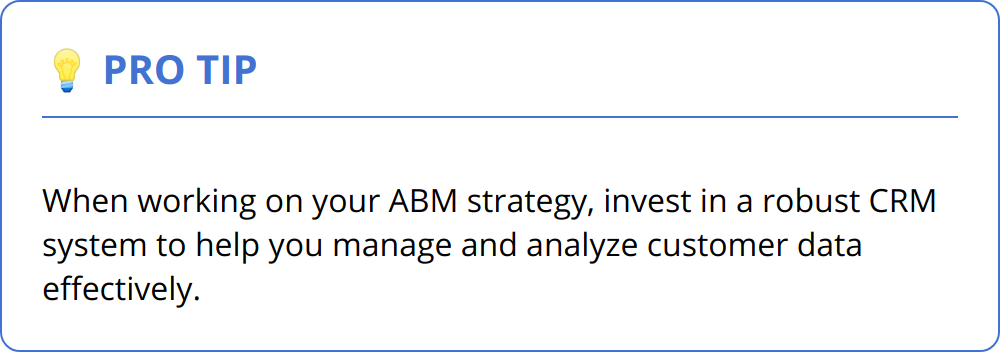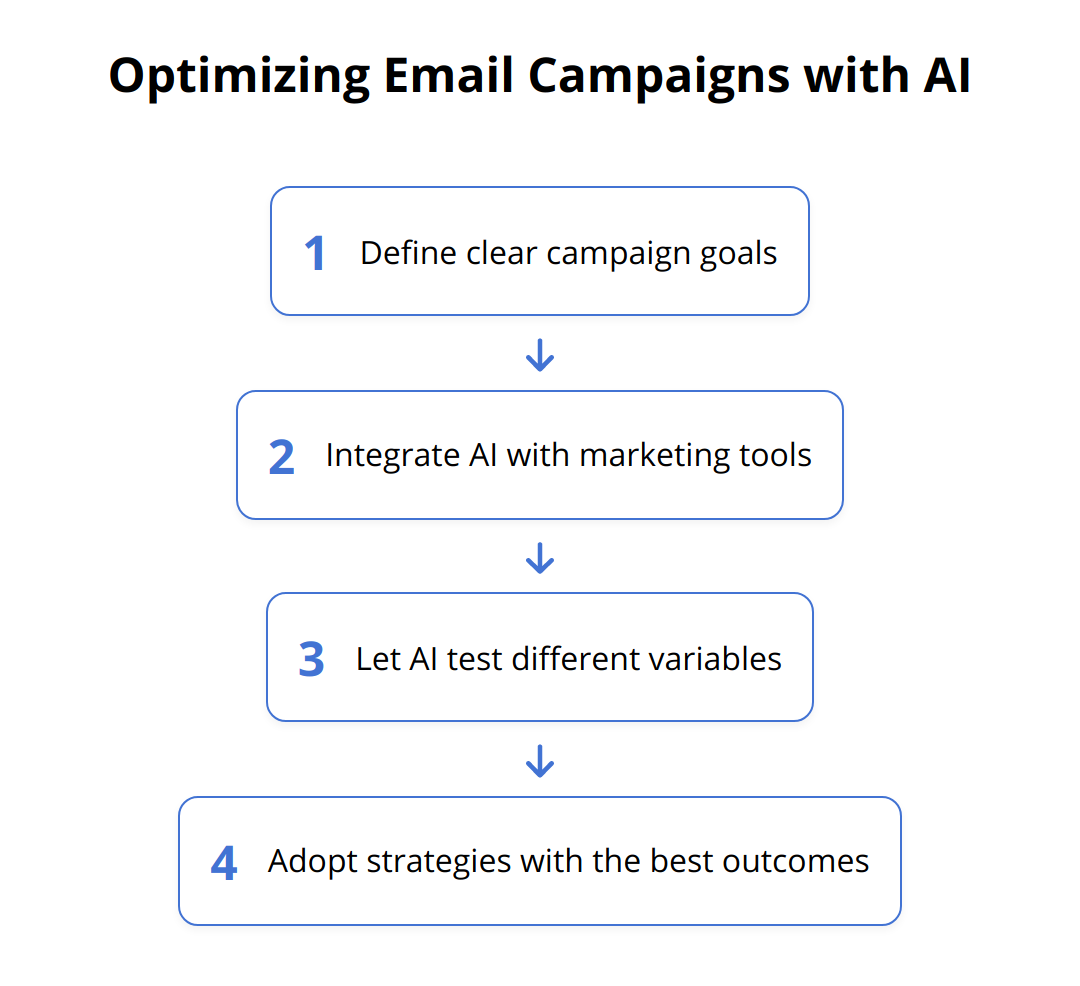B2B marketing is transforming rapidly, fueled by technology’s relentless progression. We at Emplibot recognize these shifts and understand the pivotal role they play for businesses aiming to stay competitive.
Personalization, AI, and unified marketing channels are no longer optional extras; they’re essential gears in a well-oiled marketing machine. Adapting to these innovations isn’t just about keeping up—it’s about taking a decisive step ahead in the quest for sustained business growth.
Inhalt
ToggleWhy is ABM Essential?
Account-Based Marketing, known as ABM, is rapidly becoming a staple in the B2B space. This laser-focused strategy aligns marketing and sales efforts to turn high-value accounts into customers. ABM isn’t just an improvement—it’s a revolution in how B2B companies approach their markets.
Why is it so effective? Traditional lead-generation activities can sometimes be a bit of a numbers game. With ABM, the game changes to one of precision. It’s about identifying key prospects and serving them with hyper-relevant messaging. By treating each high-value account as a market of one, B2B marketers can craft bespoke campaigns that resonate deeply, leading to much more significant engagement.
The power of personalization within ABM cannot be overstated. Companies that pivot towards personalized campaign strategies see a measurable uptick in their conversion rates. It’s about understanding the paint-points, challenges, and goals of each prospect—and then tailoring the conversation accordingly.

Consider these compelling data points:
-
B2B marketers report twice the number of leads when using marketing automation alongside ABM strategies compared to those who don’t.
-
About 80% of marketing professionals agree that personalized content is more effective than “one-size-fits-all” approaches.

To harness the full potential of ABM and personalization, here are some practical steps:
-
Identify and Prioritize your high-value accounts – use data analytics to score and select accounts with the highest revenue potential.
-
Map Out the Decision Makers within those accounts – understand the corporate structure and pinpoint who holds sway over purchasing decisions.
-
Tailor Your Content for each decision-maker – create content that answers their specific concerns and showcases solutions to their challenges.
-
Track ABM Campaigns Separately – measure the success of your ABM efforts independently to fine-tune methodologies for higher efficiency.
Remember, personalizing at scale is not a walk in the park. It requires a deep understanding of your audience and a robust infrastructure to deliver tailored experiences. But once you get it right, the rewards are substantial, both in terms of customer acquisition and long-term business relationships. As a testament to this, companies using ABM are likely to see a 91% improvement in conversion rates.
For further insights on enhancing conversion rates through personalization, check out our deep dive into personalized marketing with AI.
Moving forward without embracing ABM and personalization is not an option for B2B marketers who seek to thrive in today’s economy. Emphasize these components in your strategy to ensure your marketing efforts are not just a shot in the dark, but a strategic move towards greater engagement and success.
Why Integrate Marketing Channels?
A standout customer experience is the hallmark of today’s successful B2B marketing campaigns, and it hinges on seamless integration across all marketing channels. The endgame of any B2B marketer should be delivering a unified message, irrespective of the channel or platform. This isn’t just advantageous; it’s expected by modern businesses looking to foster meaningful connections with their leads.
Cross-channel automation weaves separate marketing efforts into a cohesive narrative that moves with the customer, matching their journey at every touchpoint. This omni-channel strategy is not just beneficial—it’s transforming lead nurturing into an art form. Businesses adopting this methodology are paving the way for more engaging interactions and, ultimately, higher conversion rates.
When your marketing channels are synchronized perfectly, you provide leads with a consistent and personalized experience that feels both valuable and exclusive. These efforts compound to foster trust and credibility—key pillars in the B2B arena.

Here’s how you can achieve robust channel integration:
-
Leverage Data Unification: Centralizing customer data across channels is the backbone of any omni-channel strategy. Without this, you’re navigating in the dark.
-
Automate for Efficiency: Apply tools that automate responses and interactions across different platforms. For instance, a customer engaging with an email campaign can receive a tailored follow-up message via social media.
-
Optimize for Experience: Each channel requires its unique optimization strategy. Understanding the nuances of email, social media, or direct messaging ensures your content hits home no matter where it’s seen.
Businesses that practice exceptional channel integration are already ahead of the curve. Multiple studies have shown that employing an omni-channel approach can retain an average of 89% of their customers, compared to a mere 33% retention rate for those with weak omnichannel strategies.

For a deeper understanding of optimizing your content across different channels, our in-depth guide on multi-channel marketing automation can provide you with actionable insights.
In the ever-evolving realm of B2B marketing, standing out is synonymous with integration. If you’re not harmonizing your channels, rest assured, your competitors will be, scooping up leads that could have been yours. So make channel integration a focal point of your strategy to ensure that every lead experiences your brand as a unified, concerted entity. And let the improved conversion rates speak for themselves.
Moving on, we’ll explore the latest in data-driven strategies. Stay connected to elevate your campaigns with granularity and sophistication.
Harnessing AI for Marketing Precision
Artificial intelligence (AI) has become a game-changer in B2B marketing automation, turning vast amounts of data into actionable insights and forging stronger connections with prospects. As personalization and efficiency become the watchwords for modern marketing efforts, AI is the linchpin that can transform your marketing campaigns from broad to laser-targeted.
Enriched Customer Insights Through AI
Real-time data analysis is a significant advantage provided by AI, enabling you to understand customer behavior like never before. With AI, you can automate the collection and analysis of touchpoint data to develop a comprehensive understanding of each lead’s journey. This depth of insight guides better decision-making and more nuanced campaign adjustments.
AI platforms can crunch numbers at an incredible pace, identifying trends and patterns that would take humans much longer to uncover. For instance, AI can reveal which content types are most effective at converting leads in specific industries, allowing for a more strategic content development plan.
Advanced Targeting with Predictive Analytics
Predictive analytics can be a powerhouse tool for B2B marketers. It uses machine learning algorithms to predict future behaviors based on past interactions. By analyzing the digital footprints of your target accounts, AI can score leads with a higher degree of accuracy, ensuring you prioritize your efforts towards those most likely to convert.
Predictive lead scoring takes into account a mixture of explicit and implicit data—everything from demographic information to engagement metrics. Here are some rapid-fire benefits of predictive lead scoring:
-
Increased efficiency: Focus on leads with the highest propensity to buy.
-
Better allocation of resources: Direct your marketing and sales efforts where they count.
-
Shorter sales cycles: Engage with leads that are ready to take action.
Optimized Campaigns with Machine Learning
The true strength of AI in marketing automation lies in its ability to learn and improve over time. Machine learning algorithms can analyze the outcomes of past campaigns and continuously refine the targeting criteria and content delivery to enhance effectiveness.
Consider a scenario where an email campaign’s open rate is dwindling. AI can test different subject lines, send times, and content formats to find the optimal combination that boosts engagement among your target audience.

By infusing AI into marketing automation, B2B marketers can provide hyper-personalized experiences that hit the mark every time. The competitive edge gained from leveraging AI is undeniable—businesses adopting AI for marketing optimization report substantial boosts in campaign response rates and customer engagement.
To delve deeper into predictive analytics and how it can benefit your marketing strategies, visit our comprehensive guide on predictive analytics in marketing.
In summary, incorporating AI into your B2B marketing automation strategy isn’t just smart; it’s essential for staying ahead. Let AI take the helm, and watch as your campaigns become more focused, your leads more qualified, and your conversions more frequent. Next up, we’ll turn our attention to the significance of content strategy within marketing automation. Keep your strategies sharp and your content relevant to maintain an edge in the B2B landscape.
Why Use Chatbots in B2B?
In the B2B domain, timely and effective communication is not just appreciated, it’s expected. Customers and prospects looking for solutions want answers fast, and they value interactivity. That’s exactly where chatbots and conversational marketing tools step in, enhancing customer engagement and streamlining lead generation.
Chatbots have become indispensable for businesses that aim to be responsive at any hour of the day. Unlike human staff, bots are tirelessly at your service, providing instant responses to queries. This shift towards instantaneity not only meets but exceeds customer expectations in the digital age. Here are some of the tangible benefits of implementing chatbots:
-
Personalized User Experiences: Bots can greet users by name and provide account-specific services, making each interaction feel tailored and individual.
-
Scalable Lead Handling: Chatbots can handle an enormous volume of simultaneous conversations, qualifying leads without breaking a sweat.
-
Data Gathering Powerhouses: Every chat is an opportunity to learn more about your prospects’ needs, collect feedback, and refine your sales and marketing strategies.
Streamlined lead generation is another realm where chatbots excel. They can ask the right questions to guide prospects through the sales funnel—sorting, scoring, and routing leads to the appropriate human counterpart when necessary. By initiating these interactions, chatbots help keeping your sales pipeline flowing with qualified leads.
Let’s talk real-time interactions. In a B2B setting, the early bird often gets the worm. Being available to answer questions or resolve issues in real-time can be the difference between locking in a new client or losing them to a competitor. Chatbots empower businesses to provide this level of responsiveness, fostering stronger, trust-based relationships with prospects and customers alike.
Here are actionable strategies to integrate chatbots effectively:
-
Define the Chatbot’s Role: Is it for customer service, lead qualification, or to provide product information? Have a clear purpose to guide its design.
-
Keep Conversations Natural: Despite being automated, the chatbot’s language should be as human-like as possible, aiming for a conversational tone.
-
Continuous Improvement through Analytics: Regularly review the chatbot’s interactions to identify areas for improvement and to update its knowledge base.
The introduction of chatbots into your B2B marketing arsenal is not just a trendy move—it’s a strategic decision backed by the numbers. For instance, businesses employing these automated conversational tools see an increase in lead generation by up to 67%.
Still need convincing? Check out our article on AI influencer marketing insights for a closer look at how AI, including chatbots, is reshaping engagement strategies.
By embracing chatbots, you’re not just keeping up with the trends, you’re setting the pace, giving your customers what they want before they even have to ask. Up next, we turn to content strategy. Get ready to level up your messaging efficacy and resonate with your audience like never before.
Final Thoughts
As we reflect on the transformative trends in B2B marketing automation, a clear picture emerges: technology is at the heart of strategic evolution. Personalization, AI, ABM, and integrated channels aren’t just fleeting trends; they’re the scaffolding for building roach business strategies that adapt, perform, and endure in a competitive market.
![Key Takeaways - B2B Marketing Automation Trends [Pro Tips]](https://emplibot.com/wp-content/uploads/2023/12/B2B-Marketing-Automation-Trends-Pro-Tips-6-2023-12-18-071421.6119030000.png)
Personalization is no longer a perk—it’s an expectation. ABM sharpens the focus of marketing efforts, ensuring that engagement and resources are invested where they matter the most. Meanwhile, AI is not just a buzzword but a fundamental tool that sifts through data to secure a deeper connection with potential clients. Channel integration is the glue that delivers a seamless narrative across all customer touchpoints, crucial for maximizing retention and satisfaction.
Embracing these trends isn’t just beneficial, it’s imperative for business growth. Implementing sophisticated marketing automation tools is your gateway to a highly efficient and responsive marketing ecosystem. The right tools can help you scale these strategies with ease, ensuring you stay on the competitive vanguard.
Here are key takeaways to keep in mind:
-
Tailor your approach with personalization and ABM to create compelling, relevant campaigns for your prospects.
-
Use AI to gain insights and optimize your marketing strategies continuously.
-
Integrate your channels to provide a unified, seamless experience for your customers.
-
Implement chatbots to engage swiftly and effectively, ensuring no lead goes unnoticed.
At Emplibot, we understand the importance of staying ahead in this dynamic landscape. That’s why we offer a service that publishes SEO-friendly articles to your WordPress site 100% automatically. In an era where content reigns, this kind of effortless automation not only saves time but also keeps your blog thriving with fresh content that drives traffic and keeps your audience engaged.
Ready to let technology amplify your B2B marketing efforts? Embrace these trends and wield the power of marketing automation to nurture and expand your business ventures. Remember, in the race for relevance and resonance, there’s no standing still—only forward motion toward greater achievements.
In conclusion, these emerging trends are not just passing phases but the new bedrock of B2B marketing strategy. Companies eager to grow and succeed will find adopting these technologies not just advantageous but necessary. With Emplibot by your side, you have a partner dedicated to fueling your growth—effortlessly and efficiently.











